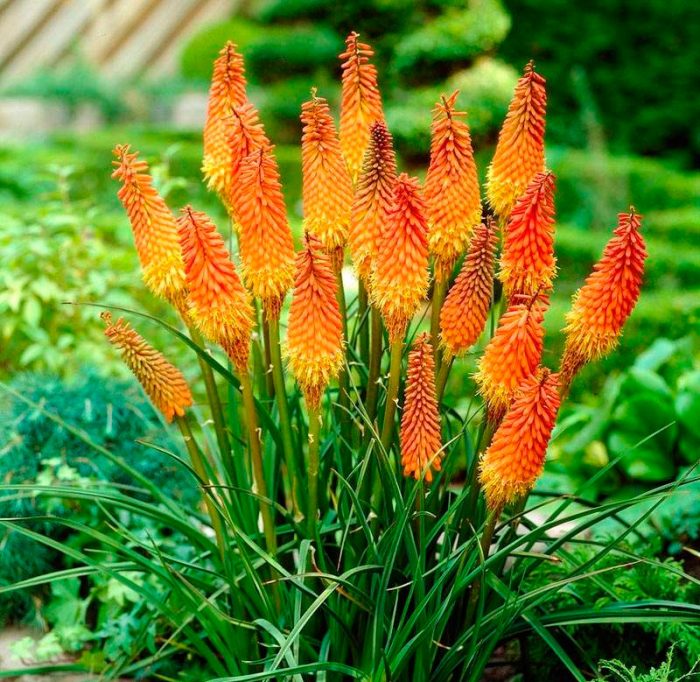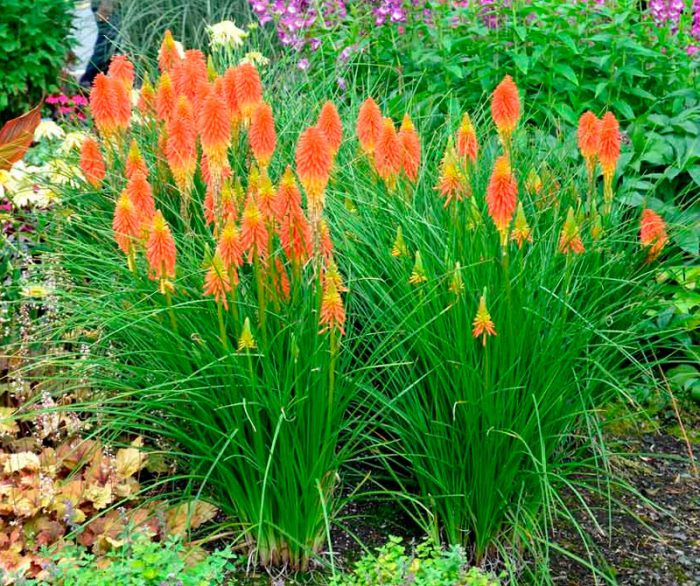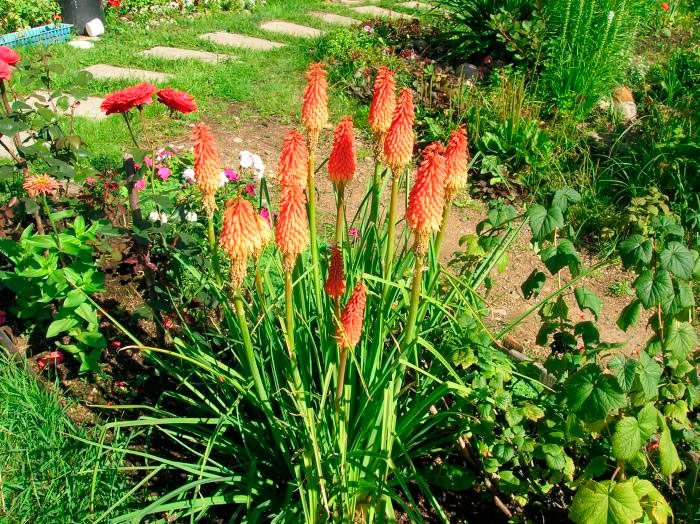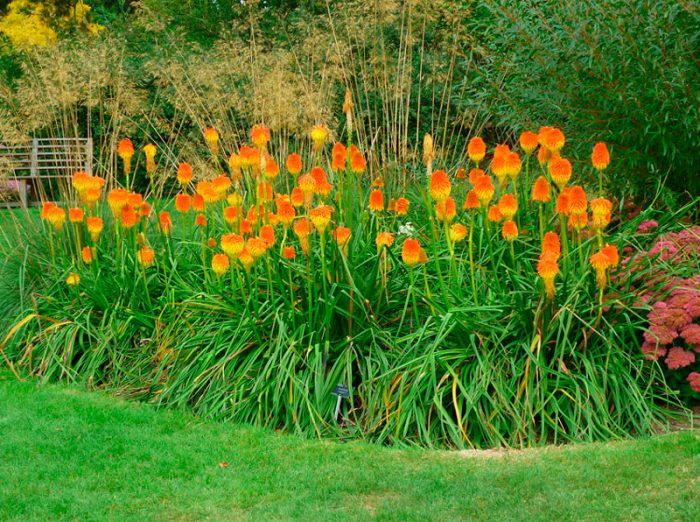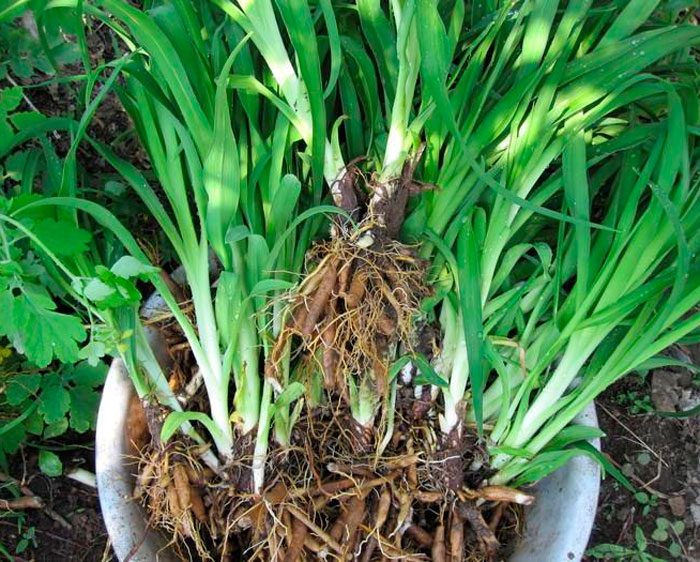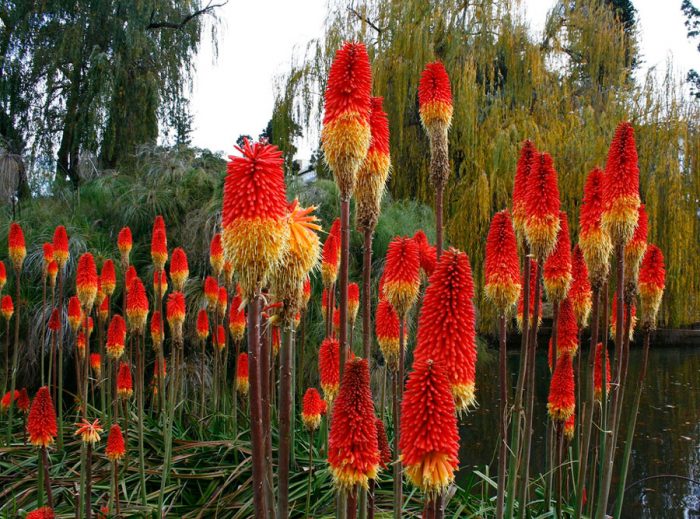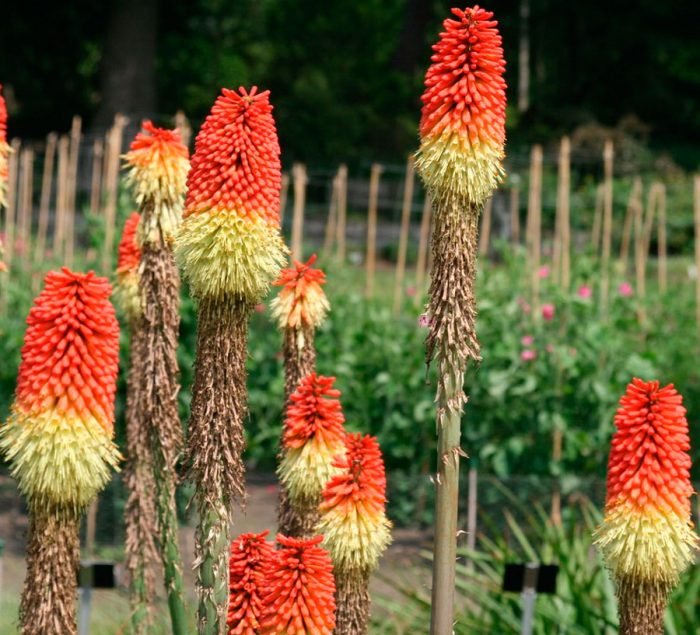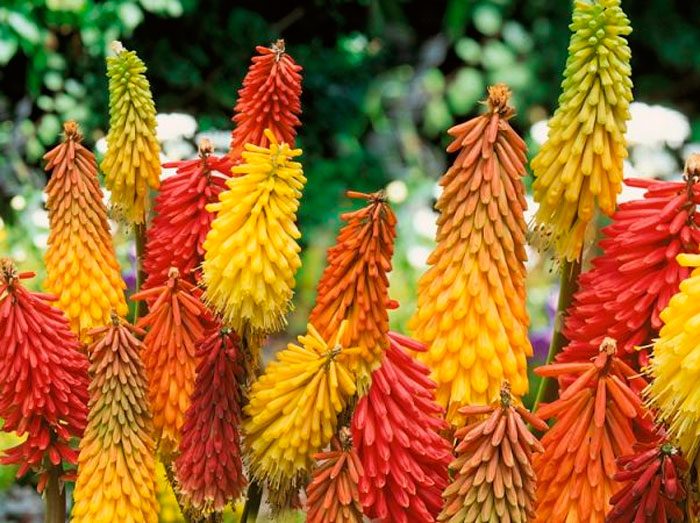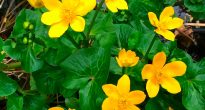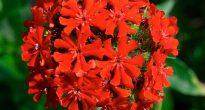The herbaceous perennial plant Kniphofia, also called Kniphofia, is a representative of the Asphodelic subfamily of the Xantorrhea family. In nature, such a plant grows in Eastern and South Africa, while it can be found at an altitude of up to 4 thousand meters above sea level. Previously, this genus was a representative of the Liliaceae family. It unites 75 species, some of which, as well as hybrids of knifofia, are cultivated as flowering plants. This genus was named after the German botanist Johann Jerome Kniphof.
Content
Features of knifophy
The flowering plant knifofia is an exotic perennial that can be evergreen. The height of the bushes varies from 0.6 to 1.5 m. At the same time, the Thomson cniphophy species can have a height of about 300 cm. The short rhizome is quite thick. The root rosette consists of xiphoid leathery leaf plates. Leafless peduncles grow from the middle of this rosette, which bear apical inflorescences of a sultan-shaped or spike-shaped form. The inflorescences include drooping small flowers of red, yellow or coral color. Such a culture has one distinctive feature, namely: the buds (most often red) and flowers (most often yellow) on the same bush are painted in different colors. Knifophya blooms in the middle of the summer period, and the faded bush does not lose its spectacular appearance until late autumn. The fruit is a capsule.
Planting knifofia in the open field
What time to plant
Knifofia is grown from seeds using seedlings. Sowing is carried out in the last days of March or the first - in April, for this they use boxes filled with soil mixture for flowers, which is previously disinfected. Cover the top of the drawers with foil. Crops before the appearance of seedlings can be placed on the windowsill or removed to the greenhouse. They will need systematic ventilation and watering. The first seedlings should appear after 15–20 days, after which they should be taught to indoor conditions, for this you need to remove the shelter every day for a while, while the duration of the procedure should be increased gradually.When the first pair of true leaf plates begins to form in the plants, they will need a pick, for this they use individual cups. It should be noted that this culture reacts extremely negatively to a sharp cold snap, as well as damp and cool weather. In this regard, planting seedlings in open soil should be carried out in July after the return frosts are left behind and warm weather sets in.
Landing rules
Shaded areas are not suitable for planting such a flower, because it belongs to the number of light-loving plants. The optimal place for planting it will be an elevation located in the southern part of the garden plot. The soil must be air permeable and moisture-absorbing. It should be borne in mind that stagnant liquid in the root system can greatly harm the plant. Sandy soil is best suited for growing such a flower, which must be loosened and fertilized before planting knifofia.
In the prepared area, it is necessary to make planting holes, between which a distance of 0.3–0.4 m is maintained. These holes must be shed with water, after which seedlings are planted in them. The size of the pits should not be less than the volume of the root system of the plant, taken together with a lump of earth. After planting the plants, the holes must be filled with the required amount of soil. The soil surface around the bushes is compacted, and the plants themselves are watered.
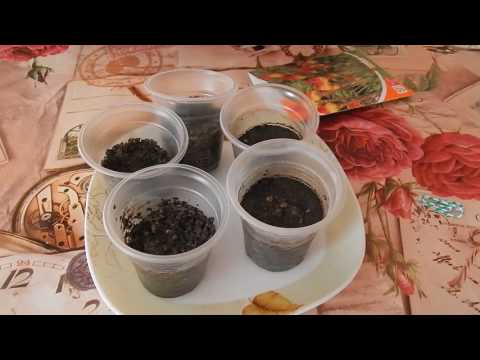

Watch this video on YouTube
Caring for knifophia in the garden
It is quite easy to grow knifofia in your garden. During the first season, after the plant is planted in open soil, it must be systematically watered, loosened the soil surface, and also remove weeds from the site. The first flowering can be seen only in the next season and only if the plant's root system gets stronger. And for this it is necessary to moisten the soil in a timely but moderate way, and also to weed and loosen the soil.
How to water and feed
Watering is carried out only after the topsoil dries out. If the weather is hot and dry, then you will have to water more often than usual. To reduce the number of weeding, loosening and watering, it is recommended to cover the surface of the site with a layer of mulch (sawdust or peat).
Top dressing of the bushes is carried out at the beginning of the spring period, before the green stems grow or during the formation of buds. To do this, use nitrogen-containing fertilizers or organic matter, and when the bush fades, it is fed with potash mineral fertilizer.
Wintering
When grown in mid-latitudes, such a crop is not long-lived, however, for several seasons, knifofia may well decorate your garden. In a faded bush, you need to cut out all the arrows, but you do not need to touch the foliage. When preparing a flower for wintering, its leaf plates are neatly tied, then the bush itself must be covered with a layer of peat chips, which are thrown from above with spruce branches. On top of such a shelter, you need to lay a moisture-proof covering material, for example, a film or roofing material. In the springtime, the shelter from the bushes must be removed. Then inspect the bushes and cut off any frost-damaged or yellow leaf plates.
Transfer
If you dig a bush for the winter and bring it into the house, then it will be possible to prolong its life. To do this, the flower is removed from the soil, then it is planted in a voluminous pot and placed in a cool room for the winter. Make sure that the root system of the knifofia does not dry out; for this, it must be watered with a little water if necessary. Planting a bush in open soil is carried out in the last spring or first summer weeks.
Diseases and pests
If you strictly adhere to the agrotechnical rules of this culture and properly care for the knifofia, then the flower will rarely hurt. Leaf-eating pests can settle on it.If this happens, then the bushes need to be treated with an insecticidal solution.
Watering such a flower too often and abundantly can cause rot on the root system. The plant can only be saved if the disease is detected at the very beginning of its development. For this, the bush and the surface of the soil near it are treated 2 or 3 times with a solution of a fungicidal preparation. If the knifophia is very badly affected by rot, then it should be removed from the ground and destroyed. If this is not done, the infection can spread to neighboring plants.


Watch this video on YouTube
Types and varieties of knifofia with photos and names
In Europe, a relatively small number of types of bniphophy are cultivated.
Kniphofia tuckii
This species is native to the southern part of the African continent. It was discovered in 1892, and was discovered by a scientist, after whom this species is named. The height of the bush is about 0.8 m. The length of the greenish leaf plates is up to 0.4 m, they have a xiphoid shape. Inflorescences, reaching a length of 15 centimeters, consist of red-yellow flowers, while the buds are painted in reddish color. Taka differs from other types of cniphophy in the highest resistance. In this regard, this species has gained great popularity among gardeners of middle latitudes, since the bushes can be left in the ground for wintering, but provided that they are well covered.
Berry Kniphofia (Kniphofia uvaria)
In nature, this species can be found only in the Cape Province. The height of a vigorous bush is about 200 cm. The length of the green-gray leaf plates is about 50 cm, they have a xiphoid shape. Large inflorescences reach 0.25 m in length, the lower flowers are yellow-green, and the upper ones are red-coral. Such a plant blooms for about 8 weeks. It has been cultivated since 1707. Varieties and forms:
- Large-flowered form... The height of the bush is about 1.3 m. The length of the inflorescences is up to 0.3 m, they consist of flowers of a fiery red color.
- Dr. Kerr... Peduncles reach a meter length. The height of the inflorescences is about 20 centimeters, they consist of lemon-yellow flowers.
- Orange Beauty... The length of the peduncles is approximately 100 centimeters. Orange flowers are collected in inflorescences.
- Fire Flame... The flowers are colored scarlet red.
- Popsicle... Bushes reach a height of one meter. The flowers on the bottom of this variety are yellow, while the top ones can be painted in various shades from coral red to orange.
Hybrid Knifofia (Kniphofia x hybrida)
All varieties and hybrids that were created using berry knifofia are collected here. Popular hybrids and varieties:
- Abendzonne... Peduncles, reaching 1.2 m in height, consist of lower yellow flowers and upper ones - red.
- Cardinal... The bush reaches a height of 1.2 meters. The flowers are fiery red.
- Burnox Triumph... The height of low bushes is about 0.6 m. The color of the flowers is rich orange.
- Golden Skeeper... The height of the peduncles is about 1.2 m. The large inflorescences include flowers of a rich yellow color.
- Indiana... The height of the plant does not exceed 100 centimeters; it is decorated with red-orange flowers.
- Royal Standard... This variety was born earlier than others, but to this day it is very popular. The height of the bush is about 100 cm, the inflorescence includes the upper scarlet-red flowers and the lower ones are yellow.
- Prince maurito... The bush, reaching a height of 1.2 m, is decorated with large red-brown inflorescences.
- Theo... The plant is about 100 cm tall and has abundant flowering. The color of the inflorescences is red-orange.
- Rocket... Large red-cinnabar inflorescences are located on peduncles, reaching 1.3 m in length.
- Knifofia hybrid Fleming Torch... Bushes are low, about 0.6 m, they are decorated with yellow-red inflorescences.

